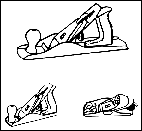
Another factor in quality is precision manufacturing. The sole of the plane should be perfectly flat and the mouth opening narrow and precisely ground for the plane to shave wood flat without splitting the grain.
There are three broad groups of planes: bench planes, block planes and special planes.
BENCH PLANES
The main variable among bench planes is length. They range from 8″ smooth planes to 22″ joiner planes.
A smooth plane is used for all-round work. Jack planes, which are longer (14″ to 18″), are heavier than smooth planes, have more cutting capacity and are used for planing rough surfaces. A fore plane is used for fine, flat finishing work. Joiner planes, the longest and heaviest made, are used to shape edges of boards so two boards may be joined together to make a close-fitting joint.
Bench planes are adjustable; the best have lateral as well as fore and aft cutter adjustment and a movable frog to vary the mouth opening.
BLOCK PLANES
A block plane is the smallest, simplest plane, used for light work-smoothing the end grain of boards and shaping small pieces of wood. It uses a single cutter blade, set at a low angle in the frame to permit better cutting. It is available in both adjustable and nonadjustable models. Adjustable planes feature steel screws, usually on the end of the plane, to vary the cutter height.
Some block planes have an adjustable mouth to vary chip thickness. A very narrow mouth is best for fine finishing, while a wider mouth allows quick stock removal on less-critical work.
SURFACE-FORMING PLANES
A surface-forming plane (also called a file) cuts rapidly and smoothly on wood, aluminum, copper, etc. It will not clog because shavings pass through holes in the body and out the top. It is made of die-cast aluminum, has high-quality steel cutting blades and is available in circular and regular patterns.
Used to shape wood in carpentry or wood sculpture, they also work well shaping plastic auto body fillers. The blade design makes them much safer than most cutting tools and easier to use than a conventional plane.
RABBET, ROUTER, AND CIRCULAR PLANES
Rabbet planes, used widely by cabinetmakers and do-it-yourselfers, cut rectangular recesses out of the edge of boards and make grooves in flat surfaces.
Router planes are used to finish common wood cuts such as dados or grooves in areas inaccessible to a regular plane. Like other planes, they have adjustments to control size and depth of cut.
Circular planes are made with a flexible steel bottom that can be adjusted to plane on concave or convex surfaces.
Check your state and local codes before starting any project. Follow all safety precautions. Information in this document has been furnished by the North American Retail Hardware Association (NRHA) and associated contributors. Every effort has been made to ensure accuracy and safety. Neither NRHA, any contributor nor the retailer can be held responsible for damages or injuries resulting from the use of the information in this document.

